“It is absurd to look for perfection.” Camille Pissarro
In this post, I take a closer look at the interesting life and art of Camille Pissarro. His work is colorful, and adventurous, and played a pivotal role in the development and popularity of Impressionism. However, he is often overshadowed by fellow artist and friend, Claude Monet.
I cover the following areas:
- Key Facts and Ideas
- How Pissarro Worked
- A Closer Look at Some of His Paintings
- Key Takeaways
- Sources and Additional Readings
- Want to Learn More?
- Thanks for Reading!
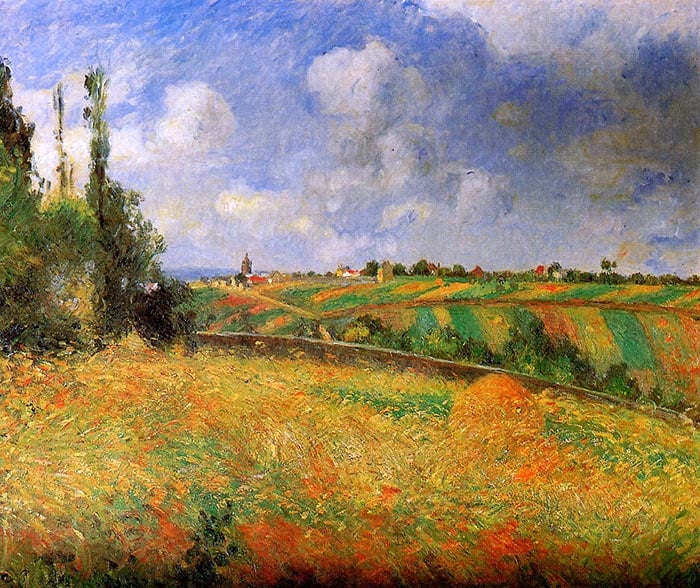
(Before diving into this post, make sure to pick up a copy of my free Landscape Painting Starter Kit.)
Key Facts and Ideas
Here are some of the key facts and ideas about the life and art of Pissarro:
- His first teacher was artist Fritz Melbye, who mostly painted dramatic seascapes. It was Melbye who first encouraged Pissarro to pursue a career as a fine artist.

- Pissarro later studied under Gustave Courbet and Jean-Baptiste-Camille Corot, who were both accomplished artists in their own rights. You can see the influence of these artists through Pissarro’s early work, which is much more restrained than the colorful depictions we know him for today. Pissarro also had ambitions to exhibit at the prestigious Salon exhibition in Paris, which notoriously favored academic painting styles.

- 1859 was an important year for Pissarro. It was the first time he exhibited in the Salon (unfortunately, I have been unable to locate information on what work he exhibited). It was also the year he met Claude Monet and Paul Cézanne whilst studying at Académie Suisse. The three artists shared a disdain for the Salon’s preference in academic art and would end up playing pivotal roles in the development of Impressionism.
- Pissarro would later exhibit in the Salon des Refusés, which was established for the many artists who were rejected by the official Salon. The Salon des Refusés also paved the way for the first Impressionist exhibition.
- In the early 1870s, Pissarro and his family were forced to relocate to London due to the Franco-Prussian War. He would find most of his work destroyed when he returned to his home in France (some 1,500 works).
- Despite the setback, he continued working and took part in every Impressionist exhibition from the first in 1874 to the last in 1886. Below is one of the five paintings he displayed at the first exhibition:

- During the 1880s, Pissarro moved into Post-Impressionism, which he considered to be a “phase in the logical march of Impressionism”. During this time, he worked with artists Georges Seurat and Paul Signac who were exploring different approaches to painting, particularly to do with color. They started using a pointillism technique, which involves painting with small dabs of distinct color (rather than blended color), as shown in Brick Factory Deepali in Eragny (below).

- Pissarro ended up leaving Post-Impressionism, explaining to a friend:
“Having tried this theory for four years and having then abandoned it … I can no longer consider myself one of the neo-impressionists … It was impossible to be true to my sensations and consequently to render life and movement, impossible to be faithful to the effects, so random and so admirable, of nature, impossible to give an individual character to my drawing, I had to give up.”
- He suffered from an eye condition during his later years which partially restricted him from painting outdoors. (What a frustrating predicament-to be an artist with compromised sight).
- He passed away in Paris on 13 November 1903 at the age of 73. His life had a profound influence on many other esteemed artists. Mary Cassatt said he was “such a teacher that he could have taught the stones to draw correctly.” Cézanne said “he was a father for me. A man to consult and a little like the good Lord.”
- His family would go on to continue his legacy, with many of his children and grandchildren pursuing a life in the arts. His son Lucien, who adopted a similar Impressionist style from his father, described him as a “splendid teacher, never imposing his personality on his pupil.”

(Before you continue, take a moment to look at one of Pissarro’s final self-portraits above—an old man with a life of painting behind him. Now go back to one of his first self-portraits at the start of this post—a young man at the start of his journey. It is always interesting to compare self-portraits from different points in an artist’s life.)
How Pissarro Worked
We are lucky in the sense that much of Pissarro’s life is documented through his many letters to friends, family, and artists.
What better way to learn about how Pissarro’s worked and his general philosophies as an artist than from his own words. Below are a handful of extracts from his many letters which I think are particularly interesting, along with some brief commentary. If you have time after reading this post, I suggest you take a look through the many other resources provided at the end, as this is just a snippet of the information available.
Pissarro on subject selection and the challenges of painting outdoors:
“I am hard at work, at least I work as much as the weather permits. – I began a work the motif of which is the river bank in the direction of St. Paul’s Church. Looking towards Rouen I have before me all the houses on the quays lighted by the morning sun, in the background the stone bridge, to the left the island with its houses, factories, boats, launches, to the right a mass of pinnaces of all colors. Yesterday, not having the sun, I began another work on the same motif in grey weather, only I looked more to the right. I must leave you for my motif. I have a room on the street. I shall start on a view of the street in fog for it has been foggy every morning until eleven o’clock-noon. It should be interesting, the square in the fog, the tramways, the goings and comings.” Letter from Pissarro to his son Lucien dated 11 October 1883
Painting outdoors comes with many challenges-the changing light, the subject moving, wind blowing, etc. As Pissarro explained above, a great solution to this is working on multiple paintings at the same time. When conditions change significantly, pick a different motif and start a new painting. You can always go back to an earlier painting when conditions are suitable again. For example, if you are painting a foggy landscape and the fog starts to fade, consider pausing and coming back when it is foggy again.

Pissarro on the importance of drawing:
“I recognize fully that you do not draw well, my dear Lucien. I told you any number of times that it is essential to have known forms in the eye and in the hand. It is only by drawing often, drawing everything, drawing incessantly, that one fine day you discover to your surprise that you have rendered something in its true character.” Letter from Pissarro to his son Lucien dated 1883
You can see his proficiency in drawing through his paintings of architecture, like the two paintings below. Do not be fooled by his painterly and almost chaotic brushwork. His fundamentals, including drawing, are strong; this allows him more flexibility with his brushwork. From what I have read, he was largely self-taught in drawing, practicing from an early age.


Pissarro on the fear of judgment and his own worthiness as an artist:
“I have just concluded my series of paintings, I look at them constantly. I who made them often find them horrible. I understand them only at rare moments, when I have forgotten all about them, on days when I feel kindly disposed and indulgent to their poor maker. Sometimes I am horribly afraid to turn round canvases which I have piled against the wall; I am constantly afraid of finding monsters where I believed there were precious gems! Thus it does not astonish me that the critics in London relegate me to the lowest rank. Alas! I fear that they are only too justified! – However, at times I come across works of mine which are soundly done and really in my style, and at such moments I find great solace. But no more of that. Painting, art in general, enchants me. It is my life. What else matters?” Letter from Pissarro dated 20 November 1883 (recipient unknown)
If you are ever lacking confidence, remember even great artists like Pissarro went through times of uncertainty and self-doubt. We tend to forget that they were working artists trying to make it on their own journey.

Pissarro on the benefits and compromises of pointillism:
“I think continually of some way of painting without the dot. I hope to achieve this but I have not been able to solve the problem of dividing the pure tone without harshness.. How can one combine the purity and simplicity of the dot with the fullness, suppleness, liberty, spontaneity and freshness of sensation postulated by our impressionist art? This is the question which preoccupies me, for the dot is meager, lacking in body, diaphanous, more monotonous than simple, even in the Seurat’s, particularly in the Seurat’s [paintings].. I’m constantly pondering this question, I shall go to the Louvre to look at certain painters who are interesting from this point of view. Isn’t it senseless that there are no Turners [here].” Letter from Pissarro to his son Lucien dated 6 September 1888
He touches on some interesting points about the limitations of our paints and how we see color. You see, the more we mix our paints, the less rich, vibrant, and brilliant the colors become (you will all be familiar with the “mud” which is left on the palette after a long session). The Post-Impressionists like Seurat were trying to side-step this limitation by painting with small dabs (or points) of distinct, unmixed color, thinking this would produce more brilliant colors than what you get from blending. But, as Pissarro points out, there are compromises when you only paint in small dabs of color.

Cézanne on Pissarro’s use of color:
“That is why, perhaps, all of us derive Pissarro. He had the good luck to be born in the West Indies, where he learned how to draw without a teacher. He told me all about it. In 1865 he was already cutting out black, bitumen, raw sienna and the ocher’s. That’s a fact. Never paint with anything but the three primary colours and their derivatives, he used to say me. Yes, he was the first Impressionist.” Paul Cézanne
This explains the colorfulness of Pissarro’s work after 1865. On an interesting note, he painted a simple landscape on his palette below:

Pissarro on how he worked through a painting:
“Work at the same time upon sky, water, branches, ground, keeping everything going on an equal basis and unceasingly rework until you have got it. Paint generously and unhesitatingly, for it is best not to lose the first impression.”
This is how I imagine many of the Impressionists worked. The challenge of painting this way is keeping a sense of control; it can be very easy to slip from Impressionism into sloppiness.

A Closer Look at Some of His Paintings
I will now take a closer look at some of Pissarro’s other paintings, starting with a simple landscape named The Big Walnut at the Hermitage.
It features fresh and spontaneous brushwork along with a pleasant analogous color scheme. Most of the painting is kept within a tight value range, which is typical of Impressionist works. Take note of all the different green tones used throughout the painting and how the greens get a touch warmer in the light.
Tip: Green is generally considered a cool color, but remember that color temperature is relative. You could have a cool green and a warm green when compared to each other.

In the painting below, I love the subtle color changes in the sky and distant land. This soft area is broken up by the abrupt tree scumbled over the top. Also, notice the contrast between rich, saturated colors in the foreground and light, weak colors in the background.

Bank Holiday, Kew depicts the busy streets filled with people and activity. Pissarro’s loose brushwork is particularly effective for this scene as it adds to the sense of movement and atmosphere. Also, notice the subtle color changes and directional strokes used for the paved ground-this is an example of creating interest in an otherwise flat and bland area (many beginners would simply paint the street surface a flat gray).

Below is a demonstration of pointillism by Pissarro from his Post-Impressionism period. Notice the small dabs of distinct color-vivid yellows, greens, oranges, purples, blues. You can almost feel a vibration of color as your eyes dance around the painting.

Pissarro found color even during the night. Deep blues are used for the sky and shadows, with dabs of vivid yellow and orange used for the lights.

The painting below is a beautiful demonstration of contrast and framing, with the shadowed foreground framing the high-key colors in the background. Notice how much color Pissarro used for the shadows.

Key Takeaways
Here are some of the key takeaways from this post:
- Do not be afraid to experiment with new styles and approaches to painting, as Pissarro did all throughout his life. If you always paint carefully and realistically, then try taking a more spontaneous approach for a few paintings, and vice versa.
- Connect with other likeminded artists. From reading the many letters from Pissarro, you can feel a strong sense of community he had with other artists.
- Make sure you have recording procedures in place for your artworks, particularly photos. It would be a shame if any of your paintings were lost or destroyed without record (like when Pissarro ended up losing around 1,500 of his works as a result of the Franco-Prussian War).
- If you are painting outdoors, you may want to consider working on several paintings at once. Once the conditions change significantly, start working on a different motif.
- If you want to paint well, make sure your drawing is up to par. As Pissarro put it “It is only by drawing often, drawing everything, drawing incessantly, that one fine day you discover to your surprise that you have rendered something in its true character.”
- Even the great masters we study and admire today went through times of uncertainty and self-doubt.
Sources and Additional Readings
Masters of Art: Pissarro, 1989 by John Rewald
Camille Pissarro Letters To His Son Lucien, 2010 by John Rewald
Art Quotes by Camille Pissarro
Want to Learn More?
You might be interested in my Painting Academy course. I’ll walk you through the time-tested fundamentals of painting. It’s perfect for absolute beginner to intermediate painters.
Thanks for Reading!
I appreciate you taking the time to read this post and I hope you found it helpful. Feel free to share it with friends.
Happy painting!
Dan Scott

Draw Paint Academy

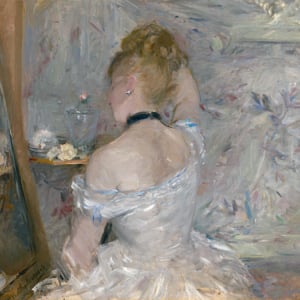
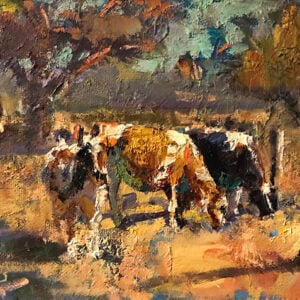
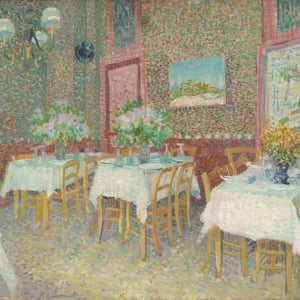
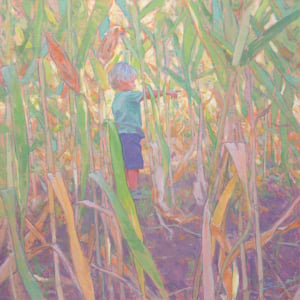
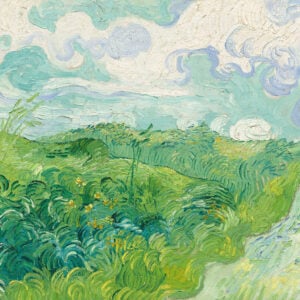
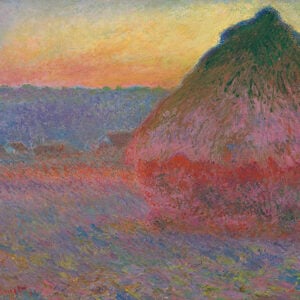
Thank you for this illustrated account of the work of Pissaro which I much enjoyed and want to share with my art teacher. I love the palette turned into a painting – what a clever man! His insistence on the exclusive use of the three primary colours as a starting-point for mixing other colours coincides with what I was taught in art development class. His letters to his son sound a bit more insistent certainly on the subject of drawing than his son’s flattering account of him as a teacher.
I learned a great deal from this post. Many thanks.
I need to really learn to draw and I have been lazy about this. Painting is just so much fun for me but I need to get more serious. Great reminder from a master
Once again a fabulous post Thank you Shirley
It is sad, in a way, to refer to his paintings as abstracts because I think they are lovely and I think those images would look like that to me if I removed my glasses.
Thank you compiling this illustrated review of Pisarro and his approach and love of painting and art in general. I particularly appreciated his self-critique and temerity in looking back on his pieces. Interesting, too, his strong recommendation to use only primary colors and avoid the ochres and umbers. How wonderful to have had him as a teacher and mentor.
Thank you so much for this interesting review! As always, I look forward to and appreciate all your posts.
Thank you for giving lessons in art history and technique. I find it most helpful to learn the details of how known artists work(ed). I especially appreciate the opportunity to study and learn about their brushwork as well as their technical and philosophical approach to the process of painting.
Thank you for this awesome piece. Looking forward to your interesting articles
Thank you for sharing freely of your experience. Thank you.
Such an interesting article. I really appreciate how much detailed information you included, thank you! I had not heard of Camille Pissarro but will now be aware his works. I too loved the painting he did on his palette.
Love your commentary on artists. I learn so much from their comments and then the way you relate to the the artist and pass the teaching points on to us.
What an incredible article! Thank you for your sharing.
This was just a fabulous tribute to a truly great artist, and very inspirational. Going downstairs to the studio now. Many thanks, RJB
Thank you for the time you put into this❤️ I would not have sought this out and I really enjoyed the lessons 🙂
Thank you Dan, you have provided a very interesting and useful insight into Pissarro. Truly inspirational.
Wonderful article, thank you Dan. I really appreciate just how much useful and interesting information you provided. I did not know anything about Camille Pissarro but will now be on the lookout for his works. I too loved his pallette painting.
Excellent information. I knew of Pissarro when I was a child because my parents had books on art about the house. But now I am over 70 and feel that I really know him!
Wonderful Pissarro!
Thank you for sharing this wonderful article on Pissarro. It makes me want to go and buy or borrow books from the library to learn even more about this great artist.
Hi Dan, nice to know about Camille Pissarro and his works of art. Painting on palette was amazing. I liked your guide as well .Thank you for sharing.
Really wonderful read. Thank you.
Dan
Your writing is wonderful and give a great insight into the masters and how this can be used in our work. I look forward to your emails with delight.
Yours is a brilliant exposition of Pissaro’s work. I hope in your future analyses you will expand on the practical techniques of pointillism so that art students can experiment with this exciting new process. Your insight into and the explanations of masters’ work is extremely helpful.
I’m a 64 year old dabbler for fun and I find your posts interesting as well as educational. The Impressionists have always been my favorites. This has been my favorite post so far. Pissarro not only was a great artist but seems like he was also a nice guy. Thanks for showing us his human side as well as his beautiful art.
Thanks Dan . I enjoyed reading about The life and art of Pissarro. Interesting history and information.
Wonderful inspiring reading! Thanks for taking the time and effort to generously share with us I learned a lot!
I worked the landscape for 22 years, a lot outside. I removed the insects with their nails, just for the sake of painting a fence. I am obsessed with the fences, because they stop, I do not give free. The freedom in painting now determines me to be more open. As the world closes. Dan, you are probably one of the best thinkers in art. Special thanks, Dan Ioja!
thank you for your time an enjoyable read I look forward to others
Love Camille Pissarro, thoroughly enjoyed your points Dan. Was particularly interested in the Bank holiday at Kew. The way he brought the houses together with the same colours and used the same colours for some of the people. Very harmonious. Thankyou for a thoroughly enjoyable half hour!
Adding my appreciation and delight to all the others here before me who have so articulately praised your work! It so wonderful to be able to view images of such a great collection of Pissarro’s work along with your review and research. Bravo. No doubt, Dan, you are building on the great art work of so many people! Thank you.
Thank you, again, for providing us with a snapshot of one of the old masters. I agree with Marti when she said she really enjoyed this article because by sharing his letters, we can really see his human side… his sometimes self doubt, his concern and advise to his son, and his realizing that a style of painting that works well for someone else really wasn’t what suited him, thus, keep trying other approaches and techniques until you find your own style. I really appreciate all the time and research you do to compile
these posts. They are informative and so interesting, especially providing the photos of the paintings to clearly understand your analysis. Great job!
Thank you Dan,
I really enjoy your articles, great research!
Love seeing all his great works! Reading this and snow storm outside has inspired me to Draw, Draw, Draw!
Thank you Dan Scott!
Your articles are just fascinating. You have taught me so much. I’ve enjoyed every one. I’m currently using acrylics and trying to learn everything I can. Thank you, Dan
thank you so much Dan. I thoroughly enjoy your articles. They are definitly helpful with my own painting. Are Pisarro”s paintings all done in watercolour?
Glad to help! Most of them are in oils. But I think View of Bazincourt, 1889 was done in gouache or watercolor.
Thanks!
Am 85 & a dabbler.Have always like the Impressionist have all many books on them Pissarro was the father.. Many thanks to your article and comments ,which are always of high value.
Serge
I noticed a recurrent pattern in most of his paintings – the diagonal direction he takes the viewer’s eye. He is good a perspective and uses it a lot.
You give Pissarro the great acclaim that he deserves. Perhaps there is too little emphasis in art history books on the influence he had on Impressionist artists that followed. You have chosen some beautiful works to illustrate the points you make.
Many Thanks for the post and the time taken to put it all together.
Wonderful, very instructive!
What a wonderful article. I just started painting last year just to entertain myself during Covid restrictions. I can’t stop painting. I have never had a lesson and have destroyed more paintings thanks I was satisfied with. Learning by trial and error. I am happy I came across you on the internet! I can’t wait to get another email.
OMG! How interesting to read about the problems the artists in the olden times had to deal with. We are not alone. Its very encouraging to read about how Piscatto delt with his problems. Hope i spelt his name right!
I’ve been reading a lot of Pissaro books and never came across anything about his process, this this was somewhat enlightening, thank you!
You are right about working in different styles, but I must warn that galleries HATE it when an artist does this. I’m retired now and don’t care about gallery acceptance, so I paint however I want. But a young person who is starting a pro career as a painter should probably make sure they have one style down pat before trying others – or in lieu of that, don’t show the experiments to galleries.
I’m always amazed at how most of Pissaro’s works are sublime but some are just not really very good, in my humble opinion. Nobody bats 1000 every day, so it’s understandable, but so many worship at his alter and think every piece is fantastic. From what you’ve shown here, I doubt he’d think that at all! I like seeing some of his “duds” (although his duds are worth more than any painting I’ll ever make!) because they help me see that I’m not really too bad a painter compared.
Nice stuff
What a fabulous post! So
Much i did not know and always wonderful to get an artists incites. Thanks!!!
I loved these comments about Pissaro. He was a very inspirational artist but I agree with what Keith J Hampton said – some of his paintings were not that good – but you can see that all the highlighted areas in your summary are taken up by him.
Thank you so much for this beautiful accounting of Camille Pissarro. He is one of my favorites.
So nice to be an,e to learn more about Camille Pissarro. His Paintings are very inspiring. I think that I can learn more and maybe discover that one day I might be proud of my own efffort….😘
Thank you for the wonderful article on Pissarro. I knew of him and some of his works but did not think in terms of him being fearful of the quality of his works. I suffer from that roadblock also. However, I realize that it is important to confront the fears and move past them. I did that last weekend by entering a Plein Air Painting contest. I have never painted Plein Air!!! It was a very humbling and very humiliating experience. But I learned so much…about myself…about art…about kindness…about sharing!!! I would have missed out on all this had I not taken the big risk. Thank you again, Dan. I look forward to your next lesson.
Thanks Dan for your great analysis of Pissaros’ work. Although he may not have been happy with a lot of his paintings I think every painting adds to our own personal growth and so to with him. There are only happy accidents in painting not mistakes and this is how we learn anyway. I’ve just signed up for your tutorials and am working through them at the moment and enjoy your opinions on other artists as I’m hopeless at seeing why some paintings work, but with your posts I am now better at the why’s behind the compositions.
What a wonderful treasure chest you provide. Your articles are pure gems. Thank you for sharing such clarity of perception and perspective. You really shine a light on key avenues of learning in both art knowledge and the truths, of the inner journey of life.
What a wonderful tribute! Glad pissaro’s stuck to his style he loved! I love it.
Thank You for Sharing!
this had given me a good understanding of pissarro and how he creates his pictures, good job!
Joan Baker
March 21, 2022
This was very interesting, sorry I do not know artists like some of the other’s. I enjoyed Mr. Pissarro’s work, It might not work in my decor, but I liked it. My decor is mostly animals and some victorian. anyway, I enjoyed it.
Thank you Dan. Really interesting for someone who knows little about Pissarro other than that I really like his paintings. Just starting out on my watercolour journey so open to all and everything 😊